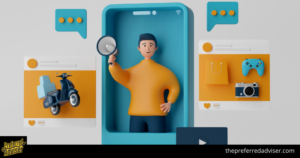You are probably familiar with Web 2.0, even if you don’t realize it.
You are a Web 2.0 expert because you found this article on our website.
Web 2.0 is the web that has been around for the past 15 years. It is the web that marketers use to help customers. Social media exists on this web, and data privacy is a regular conversation in Congress.
Web 3.0 is the next version of the web
Although it may seem daunting because it introduces a lot of new concepts that you may not be familiar with, such as cryptocurrency and blockchains, you don’t need to understand every detail of these things to know what Web 3.0 is.
Do you not understand how the current web works even though you use it daily?
Web 3.0 is the next stage of the internet’s development, where the focus is on creating a more personalised, interactive and intelligent online experience. As a digital marketing expert, you need to be aware of the changes that Web 3.0 will bring about in order to stay ahead of the curve and be able to take advantage of the new opportunities it will present.
Web3 Defined
 Even though the definition of the Web 3.0 is still being developed, that shouldn’t keep you from understanding what it is and how it will impact your marketing and business.
Even though the definition of the Web 3.0 is still being developed, that shouldn’t keep you from understanding what it is and how it will impact your marketing and business.
Be careful of companies that use the term “Web 3.0” to make their products and/or services seem better than they are.
This term, Web 3.0, was created by John Markoff in 2006 to describe applications that focus on the user experience rather than on document discovery and consumption.
The leading technology futurist, Nova Spivack, has stated that the internet is evolving from a web of connected documents to a web of connected data.
Web 3.0 is an evolution of the Web that would allow individual entities to conduct business without the need of intermediaries.
It focuses on the back-end of the web, after 25 years of focusing on the front-end.
Web3 refers to the many different ways the internet is evolving and being used by various groups.
In this system, data is not owned by any one party but is instead shared between different parties. This allows for different publishers to have different views of the data.
By using blockchain technology and artificial intelligence, individuals can own and get paid for their data with Web 3.0.
Web 3.0 provides users with control over their digital lives.
Artificial intelligence is providing evidence that more accurate and relevant information can be delivered to end users faster than through keyword searches.
An AI-powered website can filter through the data to find what a specific user will find useful according to user’s needs and context.
Web 3.0 Definition Some Marketers Give (Via LinkedIn Post Comments):
Brian Piper:
I tell marketers that Web3 is a place where consumers can work together, where people can own their data, and where things are transparent and can be verified easily. This builds trust and allows for more personalized experiences.
Janice Mandel:
The developers of Web3 are creating a decentralized internet that will enable users to have more control and engagement with customers and businesses. They recognize that with this new technology comes great responsibility to the public to maintain their trust.
The Key Features of Web 3.0
Web 3.0 is the next evolution of the Internet that will be powered by Artificial Intelligence (AI) and blockchains. These technologies will allow for platforms and services that can learn and evolve on their own, faster than people can.
It is a continued democratization of the internet brought on by the arrival of mobile device technologies. Web 3.0 is a departure from the way things are done in Web 2.0. It is a continuation of the democratization of the internet brought on by mobile device technologies.
Web 3.0’s goal is to return users full control of their digital lives, including:
- Identity: Usernames, biographies, status, profile pictures, contact info, etc.
- Digital Rights: Controlling who can license your digital creations
- History: Shopping, traveling, browsing and other activities
- Health: Medical data, visits, prescriptions, etc.
- Targeting: Control over the information advertisers are allowed to use.
How Does Web 3.0 Work
Web 3.0 starts with the Blockchain
A blockchain is a database that is shared among many different parties. The database is not stored in one central location, but is instead distributed among the different parties. Blockchains can be used to store data such as financial transactions or other information.
The technology that underlies crypto-currencies and NFTs is known for its immutability- meaning that data stored on the blockchain cannot be altered or deleted.
Decentralization is a key feature of blockchain technology. It means that the blockchain’s data is replicated over a large network of servers, making it more resistant to attack or failure.
This means that the data is secure and cannot be changed.
In Web 3.0, NFTs are used to authenticate identity and ownership rights to both digital and real-world assets including:
- Identities including Usernames, biographies, status, profile pictures and contact info.
- Digital Rights regarding who can control and/or license your creations.
- Personal history such as shopping, traveling, browsing and other online, digital activities.
- Financial assets, transactions and the use of digital wallets.
- Health information including medical data, visits, prescriptions, and more.
- Educational transcripts making it easier to verify course completions and honors.
- Advertising targeting allows individuals to control the information advertisers can use.
Web 3.0 For Marketing
 The short answer is everything
The short answer is everything
The goal of Web 3.0 is to reduce the power that large corporations currently have.
The way brands target their audiences and convert them into customers will definitely change.
Major Global Brands Are Already Acquiring Property in The Web 3.0 Metaverse:
Atari
No surprise since the Metaverse started with gaming platforms.
Atari owns property in both Decentraland and The Sandbox which visitors can use to play Atari-themed games and attend branded events.
Samsung
Samsung launched its metaverse location, Samsung 837X, in Decentraland earlier this year, which replicates the design of its flagship store in New York City.
Visitors can look at products and explore virtual worlds with NFTs, games, product demonstrations, and live shows.
Adidas
The brand has set up shop in the Sandbox and is offering a range of NFTs, experiences, and items that can be bought with its own branded currency.
Miller Lite
Molson Coors has constructed the Meta Lite Bar in Decentraland with virtual pool tables and virtual beer on tap. Win real beer and IRL experiences during the Super Bowl by visiting the Meta Lite Bar.
Advertising
 As more control over personal data and online activities is returned to users, advertisers will have less information to target consumers without first asking for their permission and, possibly, having to pay for it.
As more control over personal data and online activities is returned to users, advertisers will have less information to target consumers without first asking for their permission and, possibly, having to pay for it.
New opportunities for advertising in the Metaverse will open up. These will be similar to what companies currently do in real life and with Web 2.0 websites but will be immersive and interactive.
Advertisers will be able to pay to have their ads placed on the exterior walls of people’s homes and to sponsor product placement and events.
Direct Marketing
Several brands are already experimenting with one-of-a-kind versions of their products as a way to reward their influencers and engage customers post-purchase.
An example of this is Chevrolet auctioning off a unique NFT for a special version of its Z06 model Corvette in mint green. The real car comes free with the NFT and is guaranteed to be the only one like it.
Search Optimization
As people increasingly use voice search and digital assistants, focus will shift away from keyword optimization. Consumers will want results that are hyper-personalized, which will force marketers to optimize content for specific, long sentences.
Requires Voice Content
In the future, customers will not want to read text-based content but instead will want to interact with it vocally. They will be able to navigate the internet with the help of their favorite digital assistant, who will speak in loose sentences in the customer’s preferred language.
This means that marketers will need to create content that is more interesting and unique, and make sure it can be accessed by devices that are voice-enabled.
Web 3.0 Improving Business Success
 Businesses are increasingly using AI to understand consumer behavior and learn their content preferences.
Businesses are increasingly using AI to understand consumer behavior and learn their content preferences.
Increased personalization
Web 3.0 will allow businesses to more easily customize their products and services to individual users. This could lead to a more enjoyable experience for customers that is tailored more closely to their own personal preferences.
Greater data security
Web 3.0 provides enhanced security for businesses against cyber-attacks, helping to keep customer information safe.
Improved customer service
Web 3.0 has the potential to help businesses improve customer service by making it easier to track customer interactions and preferences. This, in turn, could lead to increased customer satisfaction.
Increased efficiency
Web 3.0 will allow businesses to automate more processes and tasks, which could lead to greater efficiency and productivity within companies.
Marketing in Web 3.0
Good news: your marketing strategy for the new web is the same as your strategy for the old one.
The principles of marketing do not change based on the platform. The same strategies for copywriting can be applied to both newspapers and Facebook ads.
The main difference is the platform (and some refreshed images).
1. Who’s Your Customer Avatar
To market any product on the web, you must first understand who your customer is.
This step is necessary for writing effective copy, developing messaging that will sell your product, and determining who your target market is.
The Customer Avatar Worksheet shows you who your customer is, on a deeper level than where they live and how old they are. Using the Customer Avatar Worksheet, you’ll figure out:
- What your customer avatar’s goals are related to (and not related to) your products: Do they want to spend more time with their family, and your productivity platform helps them get back 1 hour per day?)
- The values your customer avatar has for their career and life: Do they value the environment and reducing their fossil fuel emissions and your e-bike helps them stay aligned with that value?
- The challenges they have creating friction and pain: Is finding a drop shipping company to sell their merch through costing them hundreds of dollars in samples and your product connects them with vetted merchandise drop shipping factories?
You’ll also find out what books and blogs your target market reads, who they admire in their industry, and where they spend their time offline networking with people who have similar interests.
When you take the time to understand your audience and what matters to them, you create content that is relevant to them. This makes it easier for them to connect with your brand.
2. What After State does Your Product Create for Them
The After State is the customer’s desired end result from using your product.
This is what your potential customers have been waiting for, and your product can give it to them.
The Before State: I’m constantly worrying about my website crashing. I’m worried that my customers will have a bad experience and that I’ll lose business. The After State: I want to be confident that my website won’t crash. I want my customers to have a great experience on my site. I want to grow my business.
The Before and After Grid asks 5 questions per “state”:
- What does your customer avatar HAVE in the “Before” state? What does your customer avatar HAVE in the “After” state?
- How does your customer avatar FEEL in the “Before” state? How does your customer avatar FEEL in the “After” state?
- What is an AVERAGE DAY like for your customer avatar in the “Before” state? What is an AVERAGE DAY like for your customer avatar in the “After” state?
- What is your customer avatar’s STATUS in the “Before” state? What is your customer avatar’s STATUS in the “After” state?
- What is an EVIL plaguing your customer avatar in the “Before” state? How does your customer avatar conquer it and bring more GOOD to the world in the “After” state?
You will be able to market your products and services to your customer avatars effectively with the help of the Customer Avatar Worksheet and the Before and After Grid.
The goal is to make sure the potential customer understands what they are getting and has no reservations about it. Overcoming hesitations and clarifying the product are key to getting the sale.
3. What do They Need to Know About The Product in Web 3.0
They need to know what problems you’ll help them solve, and how you’ll do it. You still need to market your product even if you switch to Web 3. Your potential customers need to know what they can expect from your product and what problems it will help them solve.
This also applies to Web 3.0. Your customers need to understand what they will get from the product and how it will be different from other web experiences.
Completing the Customer Avatar Worksheet and the Before and After Grid is important because it provides information that can be used to improve your business. The worksheet and grid can help you understand your target market, what they want, and how you can improve your product or service to meet their needs.
. If your customer avatar is concerned about Facebook selling their data and being stalked online, you can use this as a selling point for your product/service, which offers a more private experience on Web 3.0.
Before state
The user is angry at the newsfeed for showing them products they searched on another platform and feels like their every move is being tracked by a large corporation.
After state
Do you feel free when using the internet, or do you feel like centralised corporations are selling your information?
If your customer avatar wants to move away from platforms with a central authority (such as Google, Facebook, TikTok, Twitter, etc.), and towards platforms that are decentralized and give their users ownership over their content, then that is the message you should be conveying in your marketing.
Before state
The person has a negative view of platforms that delete content without being clear about why, and feels that these platforms are not good places to build an audience.
After state
platform users no longer have to worry about their content or profile being accidentally deleted, even if they don’t violate any terms. They can feel safe growing their audience on a platform that they can take with them into the next phase of the internet.
Welcome to Web 3.0
Web 3.0 doesn’t seem as bad as it could be.
If you’re feeling lost when trying to understand cryptocurrencies, blockchains, and decentralization, don’t worry. You don’t need to understand every detail to use these platforms.
You need to know the idea, not every detail of the complex systems that create them.
As Web 3.0 becomes a bigger part of the Internet experience, marketers need one reminder: marketing on Web 3.0 follows the same rules of marketing in newspapers to billboards to websites:
- Know your customer avatar.
- Figure out the After State to write compelling messaging.
- Remove their hesitations by explaining exactly what the product is (ex. what Web 3.0 benefits they’re getting from it).

0 comments